Notable residents
| | This section needs expansion. You can help by adding to it. (September 2018) |
- Chuckie Akenz, rapper
- Paul Nguyen, film director, activist
- Jennifer Pan - Murderer, of Viet Hoa (ethnic Chinese in Vietnam) ancestry [11]
| Part of a series on |
| Ethnicity in Toronto |
|---|
Toronto has a significant population of Vietnamese Canadians. Toronto is about 1.5% Vietnamese.[ citation needed ]
Vietnamese students began attending universities in Toronto in the 1950s and 1960s. [1] Some Vietnamese professionals settled in Toronto prior to 1975. In 1972 the first Vietnamese association in Toronto was founded. The Fall of Saigon in 1975 resulted in the first wave of Toronto's Vietnamese refugees. [2] Between 1979 and 1982 12,000 persons fleeing Vietnam arrived in Toronto, and the city's Vietnamese population, including both Kinh people and Vietnamese Chinese, was about 30,000 by 1986. [3]
By 1989 the Greater Toronto Area had Canada's largest concentration of Vietnamese people, at over 50,000. [4]
By 2016 the population of Vietnamese in the Greater Toronto Area was 73,749 out of 5,928,040 which represents approximately 1.2%. [5]
The 1986 Canadian census stated that there were 7,490 Toronto residents who stated they spoke Vietnamese as their native language. The 1991 Canadian census listed 24,555 persons of Vietnamese origin in Toronto. Janet McLellan, the author of Many Petals of the Lotus: Five Asian Buddhist Communities in Toronto, stated that the census undercounted Toronto's Vietnamese population. [4]
Jane and Finch in North York has a significant Vietnamese community, about 10% of its population is of Vietnamese descent.
The Kinh people have formed various associations in Toronto. The associations manage the Canadian Vietnamese identity, offer mutual aid, mediate between community members, and to officially represent the Vietnamese community. [4] In Toronto usually Viet Hoa (Vietnamese Chinese) formed separate associations from the Kinh people. [6]
Kinh associations include Elderly Vietnamese Association, the Greater Toronto Vietnamese Refugee Assistance Committee, the National United Front for the Liberation of Vietnam, the Veterans Association, Vietnamese Association, Vietnamese Canadian Parents' Association, Vietnamese Student Society, and Vietnamese Women's Association. [4]
By 2006, in order to serve the growing Vietnamese community in Downtown Toronto, several existing neighbourhood groups and settlement groups had added Vietnamese employees. [7]
Several Vietnamese magazines are published in Toronto. [4]
From 1981 to 2010 over 60 specialty stores, cafes, and restaurants that were owned by Vietnamese people had opened in Toronto. Other businesses include real estate agencies, printing shops, auto collision companies, and jewelry stores. [1]
Buddhism and Christianity the primary religions of Toronto's Vietnamese community. [8] The Thien Tinh Tao Trang or the Thao-Duong School is the Buddhist school of the Vietnamese temples. [9] The Vietnamese Buddhist Temple has worshipers from Kinh and Chinese Vietnamese origins. [4] Toronto is a common stop for Vietnamese monks doing tours in North America. [10]
In 1976 Chan Nhu, the first Vietnamese Buddhist group in Toronto, opened. By 1992 the Vietnamese Zen Meditation Group, a Vietnamese Buddhist Association, had been founded, and there were four Vietnamese Buddhist temples opened: Amida, Hao Nghiem, Linh-Son, and Van Duc. In a five-year span additional temples were founded. [9]
The Vietnamese New Year is celebrated in Toronto. [9]
The Vietnamese community has Pham Ngoc Thuan and other folk dance groups. [4]
| | This section needs expansion. You can help by adding to it. (September 2018) |
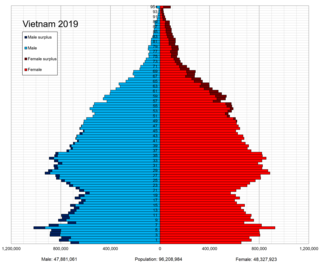
Demographic features of the population of Vietnam include population density, ethnicity, education level, health of the populace, economic status, religious affiliations and other aspects of the population.

Vietnamese Americans are Americans of Vietnamese ancestry. They comprise approximately half of all overseas Vietnamese and are the fourth-largest Asian American ethnic group following Chinese Americans, Filipino Americans, and Indian Americans. There are approximately 2.2 million people of Vietnamese descent residing in the U.S.
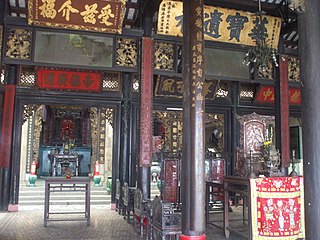
The Hoa people are citizens of Vietnam of full or partial Han Chinese ancestry. Chinese migration into Vietnam dates back millennia but contemporary Hoa today mostly refers to people of Chinese heritage who came to Vietnam from the 18th century, who especially trace their ancestry to various southern Chinese provinces. The Hoa are an ethnic minority group in Vietnam as part of the Chinese community there, and can also be found in other regions such as in the Americas. They may also be called "Chinese-Vietnamese" or "Chinese people living in/from Vietnam" by the Vietnamese.

Buddhism is among the smallest minority-religions in Canada, with a very slowly growing population in the country, partly the result of conversion, with only 4.6% of new immigrants identifying themselves as Buddhist. As of 2021, the census recorded 356,975 or 0.8% of the population.
The Demographics of Montreal concern population growth and structure for Montreal, Quebec, Canada. The information is analyzed by Statistics Canada and compiled every five years, with the most recent census having taken place in 2016.
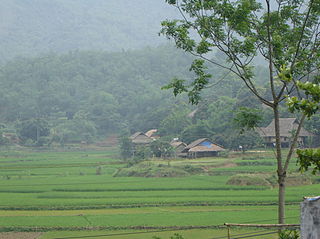
The Mường are an ethnic group native to northern Vietnam. The Mường is the country's third largest of 53 minority groups, with an estimated population of 1.45 million. The Mường people inhabit a mountainous region of northern Vietnam centered in Hòa Bình Province where they are a majority and some districts of Phú Thọ province and Thanh Hóa Province. They speak a Vietic language related to the Vietnamese language and share ancient ethnic roots with the Vietnamese (Kinh) people.

Ninh Bình is a province of Vietnam in the Red River Delta region of the northern part of the country. The province is famous for a high density of natural and cultural attractions, including reserved parks in Cúc Phương National Park and Vân Long, grotto caves and rivers in Tràng An, Tam Cốc-Bích Động and Múa Caves, historic monuments in the Hoa Lư ancient capital, Vietnam's largest buddhist worshiping complex, and the Phát Diệm Cathedral with "eclectic architectural style". Thanks to its adjacency to Hanoi, day trips from the capital are easily manageable.
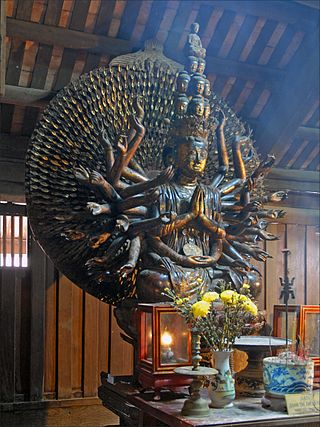
Buddhism in Vietnam, as practiced by the Vietnamese, is mainly of the Mahayana tradition and is the main religion, a combination of Pure Land and Zen (Thiền). Buddhism may have first come to Vietnam as early as the 3rd or 2nd century BCE from the Indian subcontinent or from China in the 1st or 2nd century CE. Vietnamese Buddhism has had a syncretic relationship with certain elements of Taoism, Chinese spirituality, and Vietnamese folk religion. Theravada Buddhism also exists, as well as indigenous forms of Vietnamese Buddhism such as Bửu Sơn Kỳ Hương and Hòa Hảo.

Vietnamese Canadians are Canadian citizens of Vietnamese ancestry. As of 2021, there are 275,530 Vietnamese Canadians, most of whom reside in the provinces of Ontario, British Columbia, Alberta, and Quebec.
Vietnamese Australians are Australians of Vietnamese descent. Vietnamese Australians are one of the largest groups within the global Vietnamese diaspora. At the 2021 census, 334,781 people stated that they had Vietnamese ancestry, representing 1.3% of the Australian population. In 2021, the Australian Bureau of Statistics estimated that there were 268,170 Australian residents who were born in Vietnam.

The majority of Vietnamese do not follow any organized religion, instead participating in one or more practices of folk religions, such as venerating ancestors, or praying to deities, especially during Tết and other festivals. Folk religions were founded on endemic cultural beliefs that were historically affected by Confucianism and Taoism from ancient China, as well as by various strands of Buddhism. These three teachings or tam giáo were later joined by Christianity which has become a significant presence. Vietnam is also home of two indigenous religions: syncretic Caodaism and quasi-Buddhist Hoahaoism.

The Hoa people in Ho Chi Minh City number about 500,000. They live mainly in Cho Lon, which is seen as a local Chinatown. As of 2010, the Hoa people population accounted for just 7% of the city's population, but its members owned around 30% of the city's privately held enterprises. Many of these enterprises are successful companies such as Binh Tien, Thai Tuan and Kinh Do.

The One Pillar Pagoda, formally belongs to an architecture complex called Diên Hựu tự (延祐寺) which means 'pagoda of extended blessings'. The pagoda is a historic Buddhist temple in the central Ba Đình district, Hanoi, the capital of Vietnam. The most famous part of this architecture complex is Liên Hoa Đài (蓮花臺) means 'the lotus pedestal' which is a temple with special structure: a building laid on one pillar. The original pagoda was built in 1049, had some additions and was perfected in 1105. It is regarded alongside the Perfume Temple, as one of Vietnam's two most iconic temples.
Yonsei is a Japanese diasporic term used in countries, particularly in North America and in Latin America, to specify the great-grandchildren of Japanese immigrants (Issei). The children of Issei are Nisei. Sansei are the third generation, and their offspring are Yonsei. For the majority of Yonsei in the Western hemisphere, their Issei ancestors emigrated from Japan between the 1880s and 1924.
The Laotian diaspora consists of roughly 800,000 people, both descendants of early emigrants from Laos, as well as more recent refugees who escaped the country following its communist takeover as a result of the Laotian Civil War. The overwhelming majority of overseas Laotians live in just three countries: Thailand, the United States, and France.
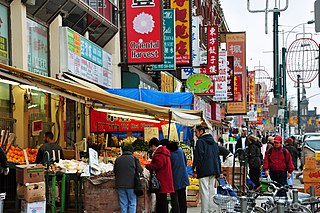
The Chinese Canadian community in the Greater Toronto Area was first established around 1877, with an initial population of two laundry owners. While the Chinese Canadian population was initially small in size, it dramatically grew beginning in the late 1960s due to changes in immigration law and political issues in Hong Kong. Additional immigration from Southeast Asia in the aftermath of the Vietnam War and related conflicts and a late 20th century wave of Hong Kong immigration led to the further development of Chinese ethnic enclaves in the Greater Toronto Area. The Chinese established many large shopping centres in suburban areas catering to their ethnic group. There are 679,725 Chinese in the Greater Toronto Area as of the 2021 census, second only to New York City for largest Chinese community in North America.
Toronto has a population of Japanese Canadians and also one of Japanese nationals. As of 2010 there are about 20,000 Japanese Canadians in Toronto. Adam McDowell of the National Post stated that Toronto's Japanese community was "never very large compared to, say, the Chinese or Italian communities".
Toronto's Cambodian population consists of 6,430 ethnic Cambodian people. In 1999, 98% of Cambodians in Toronto identified themselves as Khmer people.

There is a Vietnamese American population in Boston. As of 2012 Boston has the largest group of ethnic Vietnamese in the state. Other groups of Vietnamese are in Braintree, Chelsea, Everett, Lynn, Malden, Medford, Quincy, Randolph, Revere, and Weymouth. Vietnamese also live in more distant cities in the Boston combined statistical area and the area around Boston: Attleboro, Brockton, Fall River, Haverhill, Methuen, Lowell and Worcester.